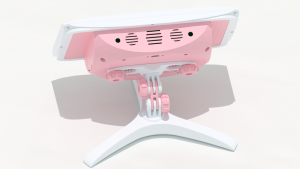CLIO Facilitator Guide
Overview
Facilitators set up CLIO kiosks and get them working as part of an exhibit.
Printable Brochure
We provide a single-page, double-sided Getting Started Facilitator Guide brochure. This guide can be printed on a cardstock and folded in half to be stored with the kiosks to assist new facilitators with setup.
Using a CLIO Exhibit Kiosk
Setting up the POP Kiosk
During storage, any mounting accessories were probably removed and the thumbscrews used to mount them were attached back to the case. First, we need to remove these thumbscrews so we can re-attach the mounting accessories. Next, orient the kiosk face down on a flat surface with the USB-C power port facing away from you. Attach the mount accessory to the bolt holes on the back or sides of the case. The mounting accessory's thumbscrews can tightened and loosened to adjust the viewing angle.
The POP Kiosk requires a 5.1V 3A power supply with a high-quality cable and USB-C adapter to perform optimally. Once plugged in, the kiosk will turn on and enter into ‘Facilitator Mode’ automatically. This interface allows facilitators to select their desired activities and change kiosk settings before entering ‘Exhibit Mode’.
Using the Interface
Getting into Exhibit Mode
Contribute
If you want to help contribute to CLIO, you've come to the right place. This is where we are trying to keep a living document based on CLIO and the way open-source technologies intersect with museums, libraries and cultural heritage centers. Sponsor us, add terms, update definitions, or provide language translations. Every little thing helps us to create a vibrant and open community geared towards one thing: equal access to technology, for everyone.
| Documentation | |
|---|---|
| Installation | Look and Feel |
| Interaction Modes | Developing Activity Types |
| Creating an Interactive | Framework |
| Integrating CLIO | Contribute |
